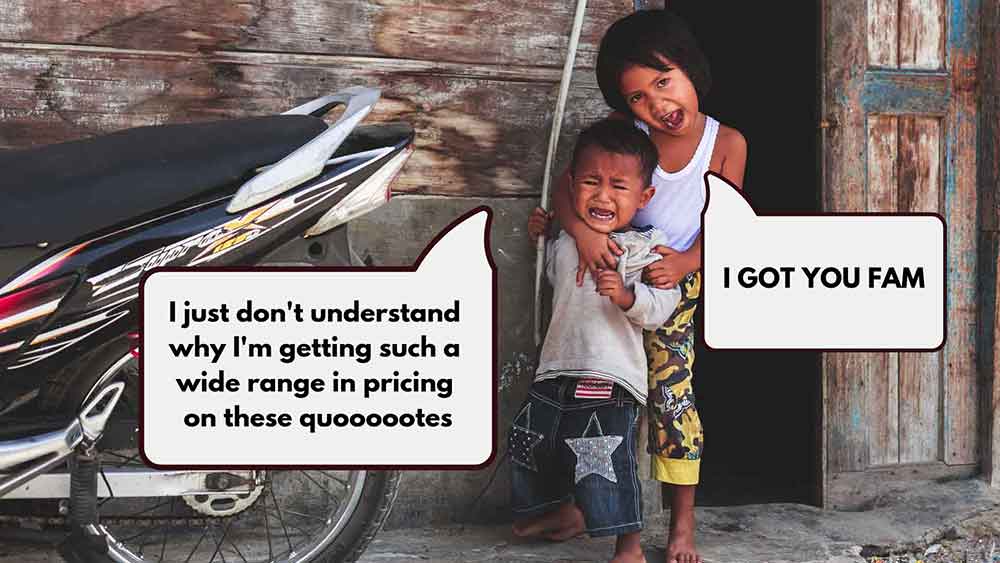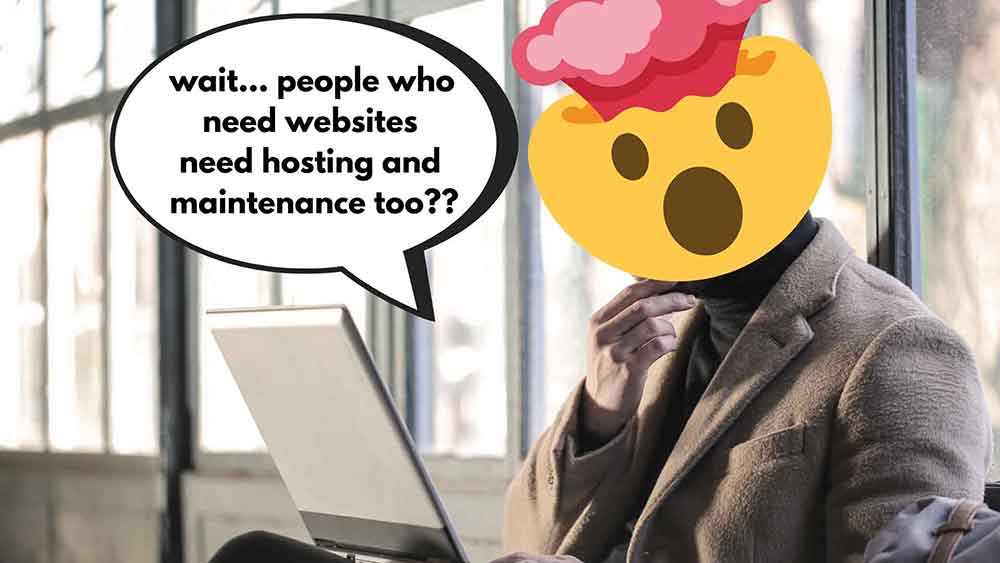Recently, someone who was interested in my web design services expressed her (all too common) frustration to me:
“I just don’t know how to do this. One guy is quoting me $400, you’re quoting me $1,500, and this other guy is saying it’s gonna cost me $10,000! How on earth do I decide which one is worth my money??”
Pricing web design services can be difficult. As it is for any digital trade.
When you get your kitchen renovated by a general contractor, you know exactly what you’re paying for. The product is tangible and you can clearly see the work that went into it. The plumbing, tiling, cabinets, and appliances are all clearly visible.
Even if you have no idea how to do the work yourself, you can obviously see that the person you hired does.
With website design, it’s not that simple.

You can try to explain all of the work that goes into building a website. The keyword research, navigation planning, sitemap structuring, search engine optimization, graphic designing, performance optimizing, yada yada yada…
But your client’s eyes are going to glaze over real quick.
Then there’s the downright shadiness of the web design industry as a whole. Sketchy web designers who make dubious claims are everywhere.
And what about those guys from overseas who low-ball their competitors by offering to build entire websites for $200?
All of this combines to make things confusing for the customer.
What can you do to alleviate your clients’ concerns while also charging a fair price for your web design services?
I’m glad you asked…
Know what you have to offer

This is step #1. How can you know what to quote someone if you don’t even know what you’re selling?
There is a wide range of skill level with a saw and hammer. If you give a saw and hammer to a professional carpenter with 20 years of experience, he could build a wonderful new kitchen table for you. If you gave those same tools to me, you’d get nothing more than a crooked, splinter-riddled stool for toddlers.
(sorry, Ron…)
You need to think about:
- What website builder are you using to build websites?
- How much experience do you have building websites?
- Do you know how to code?
- Do you have experience with niche websites like blogs and ecommerce?
- Do you have a healthy website portfolio to prove your skill level?
- How desperate are you for new clients?
Yes, I know you don’t like that last question. But it matters.
Because, the fact is, being a small business owner means the work (and money) comes in ebbs and flows.
When you’re rolling in the cash, it’s easier to charge what you’re worth without worrying about losing the client. You’d love to have them, but you don’t need them.
But when the bills are due and the cash flow is tight, you’re suddenly willing to make some sacrifices to get that client.
Some people will tell you to always charge what you’re worth and never settle. I think that’s terribly unrealistic. Especially when you’re first starting out and you desperately need to build a portfolio of clients.
Analyze the needs of the potential client

Now that you know what you’ve got to offer, it’s time to figure out what your client needs.
This is easy. All you have to do is ask the right questions and do lots of listening.
- Do you have a budget?
- Do you have a logo and brand already?
- Is this a new business or an established one?
- How many pages do you think you’ll need? (I say “think you’ll need” because most people have no idea)
- Do you need a blog or ecommerce features?
- Do you have a domain name already?
That’s it. The rest comes down to fully understanding their business and what the goal of their website should be.
The majority of your leads won’t even have answers to these questions.
Remember, they are coming to you because they don’t know anything about website design. All they know is that they want a website.
You’re the one that needs to figure out what the best solution is for their unique needs.
I once had a client come to me asking for a website with dozens of pages and every feature under the sun. Then, through our conversations, I determined that he really only need to have a simple one-page website.
I saved him a ton of money and his website now better meets the needs of his visitors.
I’ve also been at the other end of this spectrum…
Determine whether you’re the right person to meet those needs

For this step, it’s time to put your ego aside and be honest with yourself. And, more importantly, your client.
In addition to knowing what you have to offer, you need to understand your limitations.
If someone comes to you asking for something you know you have no idea how to provide them, you need to tell them that.
I once had the business manager of a famous Canadian TV celebrity ask me to quote him on redesigning their network of websites. We’re talking an at least $70,000 job here.
I politely declined. I knew it was way outside my range of expertise.
I excel at building awesome, affordable websites for small businesses everywhere. But this? This was something else entirely. And I knew I couldn’t give them what they needed.
So I told him. He really appreciated the candor and honesty.
Decide what your ideal hourly rate will be

When quoting website design services, there are basically two schools of thought:
- Hourly rate
- Project-based
Me? I like to combine the two.
I think it’s unfair to your customers to simply charge an hourly rate then bill them at the end of the job.
Not only do they not know what the total cost will be upfront, but you likely won’t get the hourly rate that you desire.
And I guarantee you will lose out on way more bids than if you had quoted a clear flat rate from the beginning.
Here’s what I recommend:
- Decide how much you want to make per hour
- Estimate how many hours the project will take to complete
- Multiply your hourly rate by that amount of hours
So, if you want to make $40/hour, and you believe the project will take 20 hours to complete, you quote the client $800.
Now, obviously you won’t be 100% accurate in your estimate every time. There will be times where you underestimate and it ends up taking 25 hours, but there will also be some that turn in your favor and it only requires 15 hours to complete.
It all balances out in the end, in my humble opinion.
The benefits of this formula clearly outweigh the negatives. Your customer will be confident knowing exactly how much their project will cost right from the beginning.
Factor in any additional services you can offer

The ideal business has a product or service that keeps customers coming back for more. For example, a subscription-based product would be perfect.
If you’re building websites for clients, they will need hosting services to keep their website up and running. Why can’t you be the one to offer those services?
Many clients like the comfort and security of knowing they have an on-call “web guy” any time they encounter problems. Why not offer a monthly maintenance service to satisfy those needs?
If you have a service that brings in continuous revenue after the website is published, it will be easier to sacrifice initial profits in building the actual website. Think of it as subsidizing the initial cost.
Remember when you bought that shiny new smartphone at a fraction of the actual cost? You ended up paying for the remainder of that phone over the next 2-3 years with your monthly phone plan, whether you were aware of it or not.
You could apply the same strategy to your web design business and reduce the barrier to entry for your clients.
They get a website built at a fraction of the usual cost, and you get a source of ongoing residual income. A true win-win.
Give them your quote
Now it’s time to send them the quote.
A great quote makes it abundantly clear what the client is getting for their money.
Many web designers like to use formal contracts as part of their proposal, going as far as to refuse any work until both parties have signed.
Personally, I hate contracts. And your clients do too.
I send my quote in a simple, bullet-point format directly in the email. Everything is clearly defined, and the client knows what they’re getting. There’s no need for legal mumble-jumble.
I honestly believe people find it refreshing.
That being said, I’ve usually built up a certain level of trust by this point. This is where great sales skills come into play.
And I have had a handful of potential clients walk away over this sticking point.
I guess that means we just weren’t a good fit for each other.
Be yourself. Be honest and transparent. And treat people with kindness and respect. You’ll be amazed how far that will take you. The principles are simple, but few choose to live by them.
Remember that you’re not a good fit for everyone

It’s important to remember that a business-customer relationship works both ways.
You will lose out on many quotes. And that’s OK. Don’t sacrifice your principles and values to force a relationship that isn’t working from the beginning.
Don’t be arrogant or proud. Just be honest about the kind of customers you’re looking for. I have turned down customers that would have paid handsomely. Simply because I knew we weren’t a good fit for each other.
That requires some deep thought. Think about who your ideal client is, then build your business around them.
The customers will come. I promise.
FAQ’s
Still got questions? Let me see if I can give you some answers.
Should I ask for a deposit?
100% yes. I like to ask for a 50% deposit, then the client can pay the remaining 50% when the site is complete and ready to be published.
How can I accept payment?
Credit cards baby. Everyone has them, and everyone wants to use them. They’re also the safest form of transaction for both you and the client. I use Stripe to process my credit card payments.
How do I invoice the client?
Once they accept your quote, just send them an invoice with the deposit requirements listed within. I like to use Invoice Ninja for all of my invoicing needs.
Should I work for free?
I won’t lie to you. When I first started my web design business, I built my first few websites for free or at a steep discount. I had zero experience and needed to build a decent portfolio. If you’re in a similar position, then yes, I’d recommend you do what it takes to get a few sites under your belt. But always with the goal in mind of building the portfolio in order to get real, paying clients in the future.
I keep getting low-balled by overseas “web designers”. Should I lower my price to compete?
No. Those guys are write-offs. Anyone who thinks they can get a website built for that cheap is not worth your time or energy. You wouldn’t believe how many horror stories I’ve heard from clients who came to me after attempting to work with these so-called “web designers”.





